Resuscitation of an orchid without roots
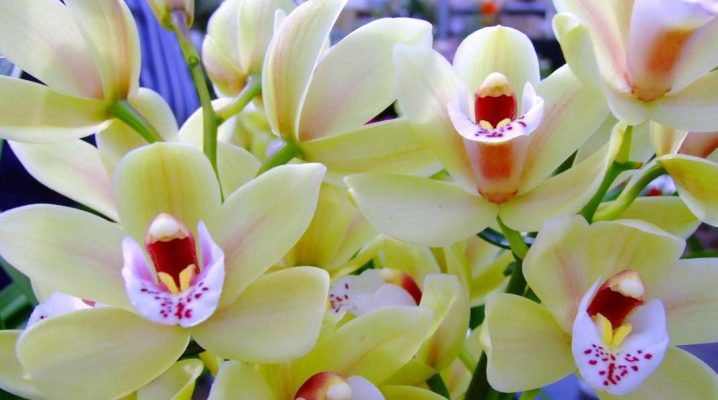
The tropical orchid is a very demanding plant and needs special conditions of maintenance and care. Failure to comply with the necessary conditions for growing this beautiful, but capricious flower can lead to rotting of its root system.
Causes of root decay
Since there are no seasonal changes in the homeland of the orchid, in our latitudes the autumn-winter period is a very difficult and dangerous time for a flower. At this time, the growth of the orchid slows down somewhat, it consumes less nutrients and water, which, in excess, accumulate in the soil.
During this period, it is very important to monitor the condition of the roots and prevent them from rotting, which ultimately leads to the death of the plant.
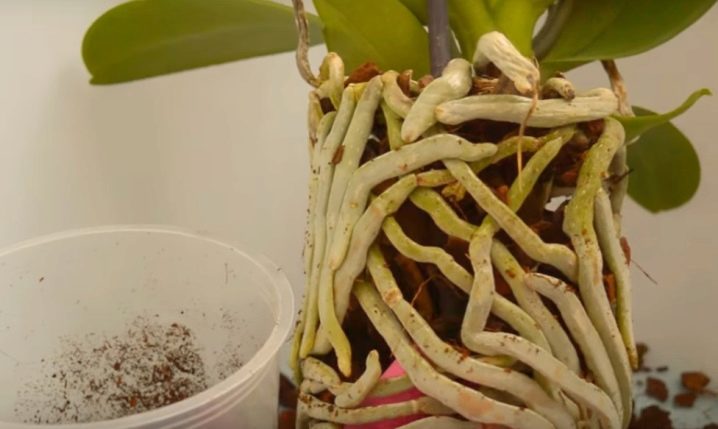
The main causes of root rot are most often several factors.
- Improper watering of the flower. Excessive watering in the absence of ventilation damages the plant. In regularly wet soil, damage to the root integumentary tissue occurs, which then penetrates deep into the roots. Excess moisture causes rotting of the root system, but at the same time, its lack leads to wilting of the plant. Therefore, when watering, it is important to focus on the condition of the soil: watering is carried out only with completely dry soil.
- Lack of light. Light is a prerequisite for photosynthesis. With insufficient lighting, the process of cell formation is disrupted. As a result, the orchid stops growing, the roots do not absorb water, begin to rot and die.
- Hypothermia... When the orchid is kept in low temperature conditions, the process of moisture consumption is also disrupted. In the cold, excess moisture has a burn effect on the roots of the flower, causing its further death. This happens most often if the plant is kept on a windowsill in winter.
- Excess fertilizer. Top dressing of high concentration can also cause burns - chemical. Even small overdoses of top dressing, as well as their application to dry soil, lead to root rot.
- Fungal diseases. They can occur when the soil is saturated with moisture. First, withered leaves appear, and then the disease spreads to the roots.
- Soil contamination with infections and harmful insects. With a long growth of an orchid in the same soil, ticks and infections can appear in it, which can destroy both the foliage and the roots of the flower.
- Dense ground. New, unused soil, consisting of individual components, loose in structure. When filling the pot, it does not fill the container tightly, there is always air between its particles, which allows the roots of the flower to breathe. Over time, soil compaction occurs, which leads to the disappearance of the layer from the air. With a lack of air aeration in a humid environment, the roots also begin to rot.
- Mechanical damage to the roots during transplantation. Broken roots must be well treated with disinfectants, otherwise the open root tissue is easily infected with various infections.

Symptoms
Root decay in an orchid affects its condition and has its own characteristic features. The main symptoms of root rot are as follows:
- leaf state change - sluggish leaves, which have become soft and wrinkled, often turn yellow, watering does not lead to their health;
- change in the state of aerial roots - they acquire a dark shade, dry out or signs of rot appear on them;
- the stability of the orchid is disrupted - it does not hold well in the pot, it can either swing strongly, or fall to one side, which happens because, having lost its roots, it cannot hold on to the soil;
- appearance on the inner surface of the pot mold or green plaque;
- stem condition - the presence of the disease is indicated by a yellowed stem along the entire length;
- lack of buds and flowering - since malnutrition affects the ability to form buds.
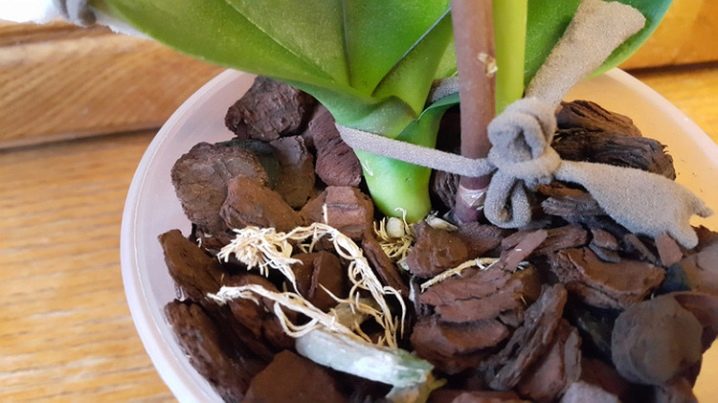
If a plant has at least one such symptom, an urgent need to check the condition of the root system. It is quite easy to determine the dead roots from living ones by such signs as:
- root color - in healthy roots, the color is whitish or greenish, and after watering, the green color becomes more saturated; diseased rotten roots are either black or brown;
- change in root structure - living roots are elastic and dense, and rotten roots are empty inside and easily wrinkle when touched;
- rooting wet, slippery spots;
- moisture release when pressing on the root;
- dead roots become like threads.
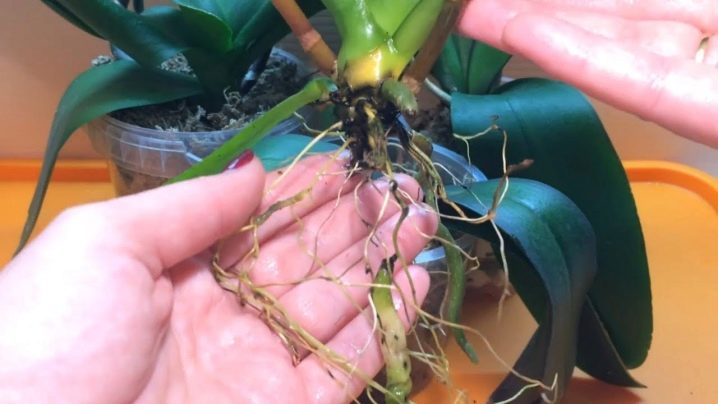
Important! In the presence of the above symptoms and signs, urgent action is needed.
How to save an orchid?
If a lesion or death of the roots is found in a dying orchid, it is necessary to immediately proceed to its resuscitation and to carry out preliminary processing of the flower. First, the plant is removed from the pot and the old soil is removed. Then you should wash the root system, dry well and examine it. It is necessary to quickly begin resuscitation in case of loss of more than 60% of the roots. To successfully leave a flower at home, you need to take several steps step by step.
- Carefully trim off all decayed and affected areas of the roots with a clean and very sharp tool. All places with minor signs of infection and in doubt are subject to pruning, since even the smallest spots of rot remain a source of infection.
- The plant is washed again with water and then disinfected. Most often, a weak (light pink) solution of potassium permanganate or fungicide is used. An effective action is provided by the preparation in the form of powder "Fundazol", crushed activated carbon and cinnamon, which are sprinkled on all the places of the cuts. However, you cannot use alcohol-based disinfectants, otherwise you can burn the plant, which will negatively affect the further development of new roots.
- Dry the orchid roots for 2-3 hours and treat with a solution of such agents as "Epin", "Zircon", "Kornevin", stimulating growth, in the ratio of 1 drop per 1 liter of water. The undamaged remaining roots are dipped in this solution so that the orchid leaves do not reach the water, and keep for about 1–2 hours.
- Then, to root the plant, it should be transplanted into a pot with fresh soil, covering the top layer of soil with moss on top. The orchid must be placed in a well-lit place, since the flower can be successfully revived only in good light conditions. In winter, when there is not enough light, additional illumination with a phytolamp is required.
It is advisable to treat the orchid leaves from time to time with a solution of succinic acid, which makes it easier for the plant to restore vitality. If there are children on an orchid peduncle, it is necessary to find out whether they were able to grow aerial roots. Such children can be planted, but it is better to cut the peduncle.
It is not recommended to separate the baby located on the root part of the stem, as this will cause additional injury to the flower.
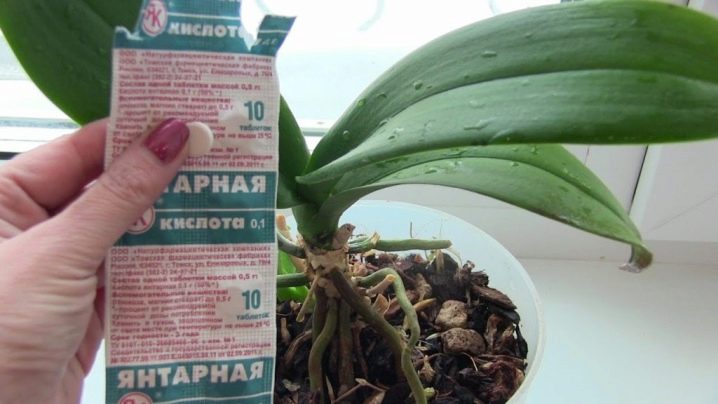
Recovery in a mine-greenhouse
An effective method for restoring a rootless orchid is to use a mini greenhouse. You can buy it ready-made in flower shops, but you can also make it yourself.Since the most acceptable temperature regime and constant humidity are maintained in the mini-greenhouse, the restoration of the weakest plants is also ensured. In a small greenhouse, the following conditions must be created:
- the temperature should be + 23– + 28 degrees, because at lower temperatures, high humidity can lead to mold, which will affect the growth and development of roots, and a higher one will burn the flower; moisture in such conditions will evaporate instead of being absorbed by the plant, as a result, the roots will form more slowly or will not grow at all;
- air humidity should be approximately 80–100%;
- lighting should be not only intense, but also diffused, while lasting at least 12 hours a day.
The revitalization of an orchid in a greenhouse can be carried out either by pre-planting it in a pot, or by planting it directly in the greenhouse. The pot is chosen with transparent walls and in accordance with the size of the orchid's leaf rosette.
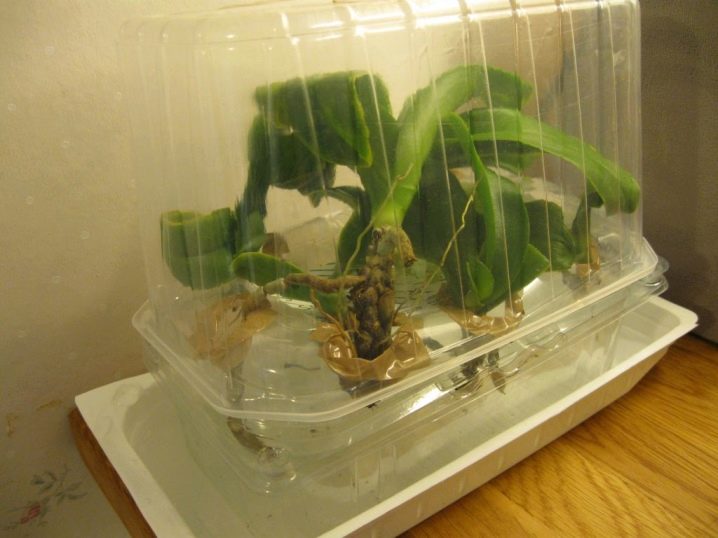
The procedure is as follows:
- the bottom of the container or pot is covered with a drainage layer of expanded clay;
- a layer of sphagnum (a type of moss) is laid on top, which is preliminarily well washed and steamed; this substrate is slightly moisturized;
- a leaf rosette of a flower is placed in a moistened substrate; if planting is made in a pot, then it is placed in a mini-greenhouse;
- a container with hot water is placed in a mini-greenhouse at a short distance from the orchid for a while and the greenhouse is covered; hot water will create a moist-thermal greenhouse effect inside;
- watering the substrate should be carried out only when necessary and not overmoisten it;
- the mini-greenhouse needs to be aired daily, it is better to do this in the evening or at night; in winter, airing lasts 20 minutes, and in summer, the greenhouse can be left uncovered until morning;
- systematically inspect foliage and root babies at the point of contact with moss; in the presence of darkened or swollen areas, the orchid must be removed from the greenhouse, dried and then placed back in the moss, but on the other side;
- regularly stimulate the development of roots, for this periodically (after 10–20 days) do fertilizing with fertilizers containing phosphorus, potassium, iron; effective use of micronutrient fertilizer "Iron Chelate", which can be applied 1 time in 2-3 days, means "Epin" and "Zircon" can be used 1 time in 30 days.
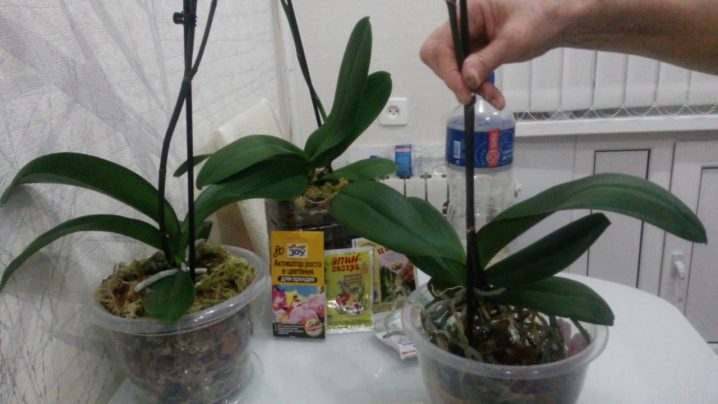
Important! In a mini-greenhouse, the flower is kept until it grows roots 2–5 cm long. Only then can the flower be planted in ordinary soil and kept in the usual conditions.
How to reanimate over water?
Another way to revitalize an orchid is the above water revitalization method. Resuscitation over water consists of actions such as:
- clean the root system - first, cut off all dry and rotten roots, dark spots on the root neck with a clean and sharp tool from the orchid;
- disinfect - in order to prevent the possible occurrence of rot, the flower is treated with a fungicide, the places of the cuts are sprinkled with crushed activated carbon;
- the plant must be left to dry until morning;
- pour water into a container with transparent walls, but so that its level is at least 1 cm below the orchid;
- lower the flower into the container with its root neck down so that it does not reach the water;
- place the flower in a darkened room.
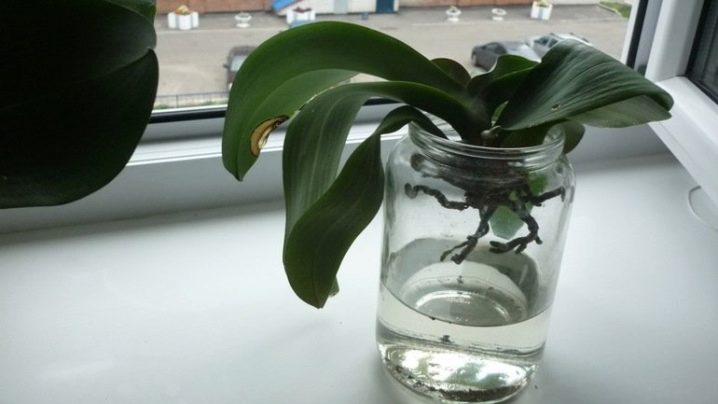
After a while, the leaves of the plant may wilt slightly and wrinkle. This is a natural process as the flower has no roots. To restore the healthy state of the leaves, they must be wiped every day with a solution of succinic acid (half of the tablet is dissolved in 50 g of water). And also you can carry out monthly 1 spraying with "Epin". After about a month, the orchid can grow young roots, and sometimes a new leaf.
In addition to root rot, orchid leaves can wither. The natural development of the plant involves wilting of the lower leaves.They do not need to be removed, as they will soon fall off by themselves. With improper care, almost all of the leaves of an orchid can become lethargic. A flower with sluggish leaves also needs healing. If the orchid has a peduncle, then its upper part must be cut off.
First of all, the plant must be placed in a darkened room, stop watering and let it rest. After a while, you can water the soil and spray the leaves with water. In addition, wiping the foliage with a honey, sugar or amber solution, as well as spraying with Epin, has an effective effect.
Flower recovery can take several days.
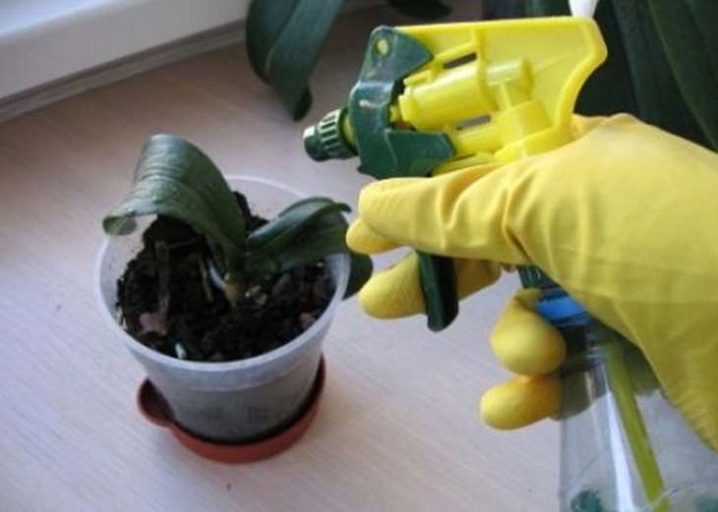
Care
The restoration of an orchid without roots is a rather long process and can last from several months to a year. It depends on factors such as:
- the number of preserved healthy roots or their remnants;
- foliage condition;
- care.
It is possible to transplant the orchid into the ground only after the young roots reach a length of 3 to 5 cm. You cannot use old containers. It is advisable to plant a flower in a peat pot. After the root system is formed in the flower, it is simply placed in a peat pot in another container with soil. The transplanted plant requires the same watering during the recovery period as when caring for a healthy orchid. To ensure the stability of a flower with still weak roots, it is necessary to put props and tie the stem to them for 2-4 weeks.
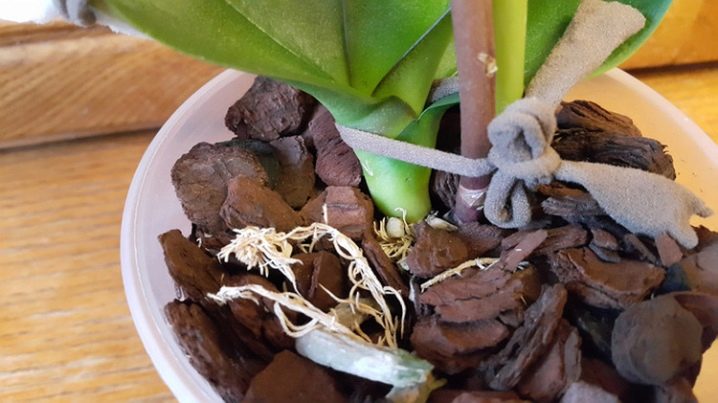
Gradually, the flower will gain strength and a baby can form on the root neck. It is recommended not to remove it, otherwise you can weaken the plant. When caring for an orchid, it is necessary to create conditions such as:
- do not allow direct sunlight to hit the flower, as this can lead to burns of still weak leaves;
- do not put a flower on the windowsill on hot days in summer;
- do not keep the plant in a draft;
- periodically ventilate the place where the flower is kept; in dry weather in summer, it is recommended to do air spraying;
- for transplanting, it is advisable to use a special soil for orchids;
- lighting should be intense, but diffused; if it is lacking, you need to apply additional illumination with a phytolamp.
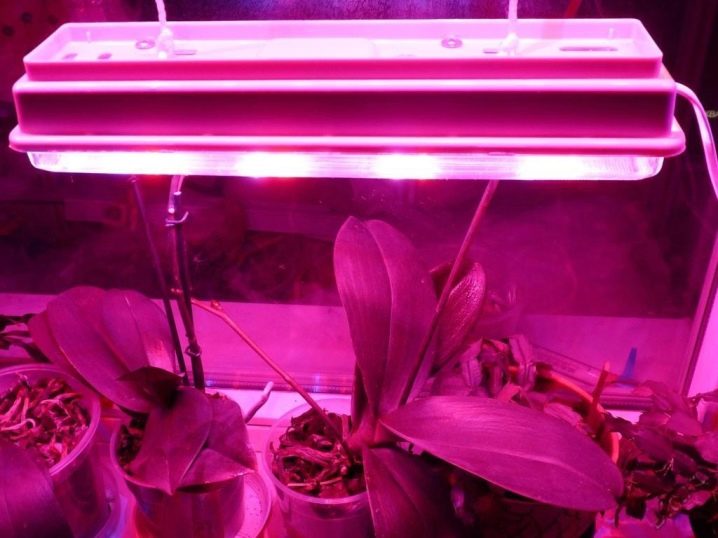
Prevention measures
The main and main measure for the prevention of root rot in an orchid is properly organized care. First of all, it concerns watering. An orchid tolerates a lack of moisture better than an excess of it. It is also important to observe the regime of aeration and lighting of the plant. It is necessary to adhere to such rules of care as:
- growing containers should be transparent and have drainage holes not only in the bottom, but also in the walls of the pot;
- the soil should contain a small amount of peat (or better without peat at all); you can use only high-quality and better special soil for orchids, having previously disinfected it;
- water the flower only after the soil has completely dried;
- to carry out the prevention of fungal diseases by spraying with fungicides.
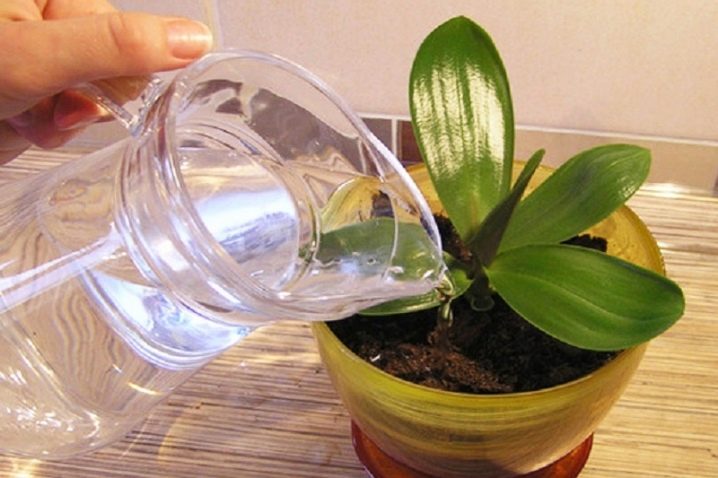
Properly caring for and adhering to these simple rules, it is quite possible to avoid root rot, the orchid will delight you with its beautiful and sophisticated flowers.































The comment was sent successfully.